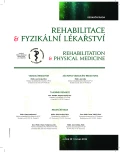-
Medical journals
- Career
Positioning Chronically Immobile and Terminally-Ill Patients
Authors: M. Kala 1,2; E. Hrenáková 1; P. Snopek 1; Z. Dorková 1
Authors‘ workplace: Univerzita Tomáše Bati ve Zlíně, Fakulta humanitních studií, Ústav zdravotnických věd, Zlín 1; Hospic na Svatém Kopečku, Olomouc 2
Published in: Rehabil. fyz. Lék., 23, 2016, No. 2, pp. 96-100.
Category: Original Papers
Overview
Aim:
The aim of this work was to determine whether the nursing procedures described in the standard textbooks reflect the specific health problems experienced by chronically immobile and terminally-ill patients.Introduction:
Chronically immobile patients and those in the terminal phases of serious illnesses tend to be affected by a number of changes in the musculoskeletal system and often suffer neuropathic pain. Positioning and manipulating such people requires a specific approach which places extra demands on carers.Methodical process and results:
An analysis was carried out of commercially available study materials in the field of nursing describing the methods used to position and manipulate patients. It was found that these methods do not take account of the specific pathological changes that accompany chronic immobility or the terminal phases of life.Discussion:
The work provides a detailed description of the pathological conditions (immobilization syndrome, hemiplegic shoulder pain, allodynia) requiring a specific approach by nursing staff and carers. It gives a detailed methodical guide to manipulating and positioning chronically immobile and terminally-ill patients. Special attention focuses on the importance of communication with patients.Conclusion:
When providing healthcare to chronically immobile and terminally-ill patients it is essential to respect the specific pathological changes, which require an increased degree of caution and care for the patient.Keywords:
patients positioning, immobility, terminal phase of life, neuropathic pain, allodynia
Sources
1. HUDÁKOVÁ, Z.: Polohovanie pacientov pomocou pohybu. Ružomberok, Verbum - Katolícka univerzita v Ružomberku, 2011, s. 11-19.
2. JUBA, K. M., WAHLER, R. G., DARON, S. M.: Morphine and hydromorphone-induced hyperalgesia in a hospice patient. J. Palliat. Med., 16, 2013, 7, s. 809-812.
3. KELNAROVÁ, J., CAHOVÁ, M., KŘESŤANOVÁ, I. et al.:Ošetřovatelství pro zdravotnické asistenty – 1. ročník. Praha, Grada Publishing, 2009, 2011 (dotisk), s. 124-125.
4. KOLÉBALOVÁ, J., KRATOCHVÍLOVÁ, J.: Rehabilitujeme doma. Brno, Moravskoslezský kruh o.s., 2010, s. 14-17.
5. MANEVICH, D., BRILL, S., HERSHKOVITZ, A.: Spontaneous insufficiency fractures of long bones in institutionalized elderly patients. Aging Clin. Exp. Res., 22, 2010, 1, s. 95-97.
6. OPAVSKÝ, J., ROKYTA, R.: Patofyziologie neuropatické bolesti. In: ROKYTA, R. et al.: Bolest. Praha, Tigis, 2006, s. 245-251.
7. VONDRÁČKOVÁ, D.: Nádorové neuropatické bolesti a jejich léčení. Neurol. Prax., 4, 2007, s. 231-232.
8. VYTEJČKOVÁ, R., SEDLÁŘOVÁ, P., WIRTHOVÁ, V. et al.: Ošetřovatelské postupy v péči o nemocné I/ Obecná část. Praha, Grada Publishing, 2011.
9. Vyhláška č. 55/2011, Sb., o činnostech zdravotnických a jiných odborných pracovníků, § 4, písmeno h).
10. WONG, T. C., WU, W. C., CHENG, H. S. et al.: Spontaneous fractures in nursing home residents. Hong Kong Med. J., 13, 2007, s. 427-429.
Labels
Physiotherapist, university degree Rehabilitation Sports medicine
Article was published inRehabilitation & Physical Medicine

2016 Issue 2-
All articles in this issue
- Spectrum, Trends and Approaches in Contemporary Neurorehabilitation
- Sonography Evaluation of Stabilization Muscles of Lumbar Spine in Vertebrogenic Patients
- Postural Stability during Standing in Subjects with L5 Radicular Syndrome
- Options of Physiotherapy for Patients with Kidney Disease, on Dialysis and after Kidney Transplantation - Overview from Past to Present
- Positioning Chronically Immobile and Terminally-Ill Patients
- The Effect of Unloader Knee Orthosis on Gait in Subjects with Gonarthrosis – Pilot Study
-
Aplikace kolenní motodlahy po totální endoprotéze
Ovlivňuje rychlost dlahy terapeutický efekt? - Possibilities of Hippotherapy for Child Patients with Cerebral Palsy
- Sacralization of Vertebra L5
- Rehabilitation & Physical Medicine
- Journal archive
- Current issue
- Online only
- About the journal
Most read in this issue- Sacralization of Vertebra L5
- Positioning Chronically Immobile and Terminally-Ill Patients
- Options of Physiotherapy for Patients with Kidney Disease, on Dialysis and after Kidney Transplantation - Overview from Past to Present
- Spectrum, Trends and Approaches in Contemporary Neurorehabilitation
Login#ADS_BOTTOM_SCRIPTS#Forgotten passwordEnter the email address that you registered with. We will send you instructions on how to set a new password.
- Career

